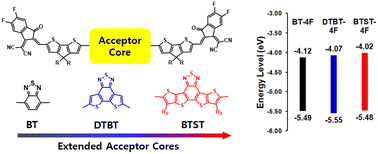Tuning the LUMO levels of non-fullerene acceptors via extension of π-conjugated cores for organic solar cells†
Abstract
We investigate how extending the length of a π-conjugated central A′ core in Acceptor–Donor–Acceptor′–Donor–Acceptor (A–D–A′–D–A)-type non-fused-ring electron acceptors (NFREAs) affects their energy level and the miscibility of donor polymer:NFREA organic solar cells (OSCs). The extended π-conjugated central A′ core increases their lowest unoccupied molecular orbital (LUMO) energy level. We designed and synthesized three NFREAs: BT-4F, which has a benzothiadiazole (BT) core; DTBT-4F, which has two fused thiophene rings on the BT core; and BTST-4F, which has two fused thienothiophene rings on the BT core. In these NFREAs, the LUMO level is upshifted in the order of increasing length of the extended π-conjugated core. The open-circuit voltage (VOC) is related to the gap between the LUMO of the NFREAs and the highest occupied molecular orbital (HOMO) of the donor polymer, thus, the VOC increased from 0.66 V in a BT-4F-based OSC to 0.81 and 0.84 V in OSCs based on DTBT-4F and BTST-4F, respectively. The PBDB-T donor polymer is more miscible with BTST-4F than with BT-4F and DTBT-4F. The BTST-4F-based blends have a narrower light-absorption range than the PBDB-T:BT-4F blends; however, because of the miscible morphologies of the PBDB-T:BTST-4F blends, the BTST-4F-based devices exhibit a comparable short-circuit current density (JSC) to that of BT-4F-based devices. These results indicate that the introduction of extended π-conjugation of the central core in A–D–A′–D–A-type NFREAs could be an effective method to increase the VOC of NFREA-based devices while maintaining a decent JSC. These results further indicate that introducing an extended π-conjugated central core is a promising design strategy to achieve highly efficient OSCs based on NFREAs.



 Please wait while we load your content...
Please wait while we load your content...